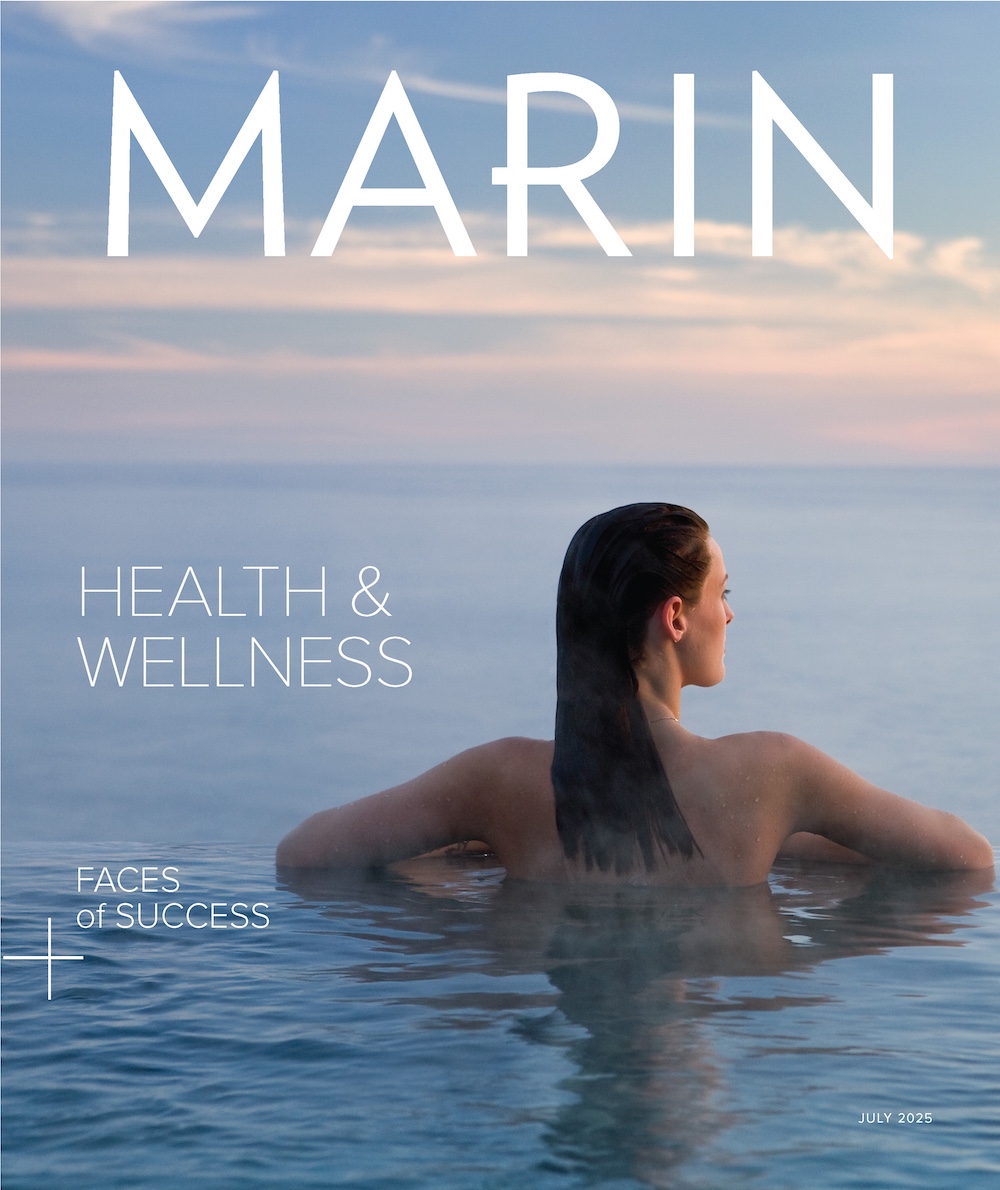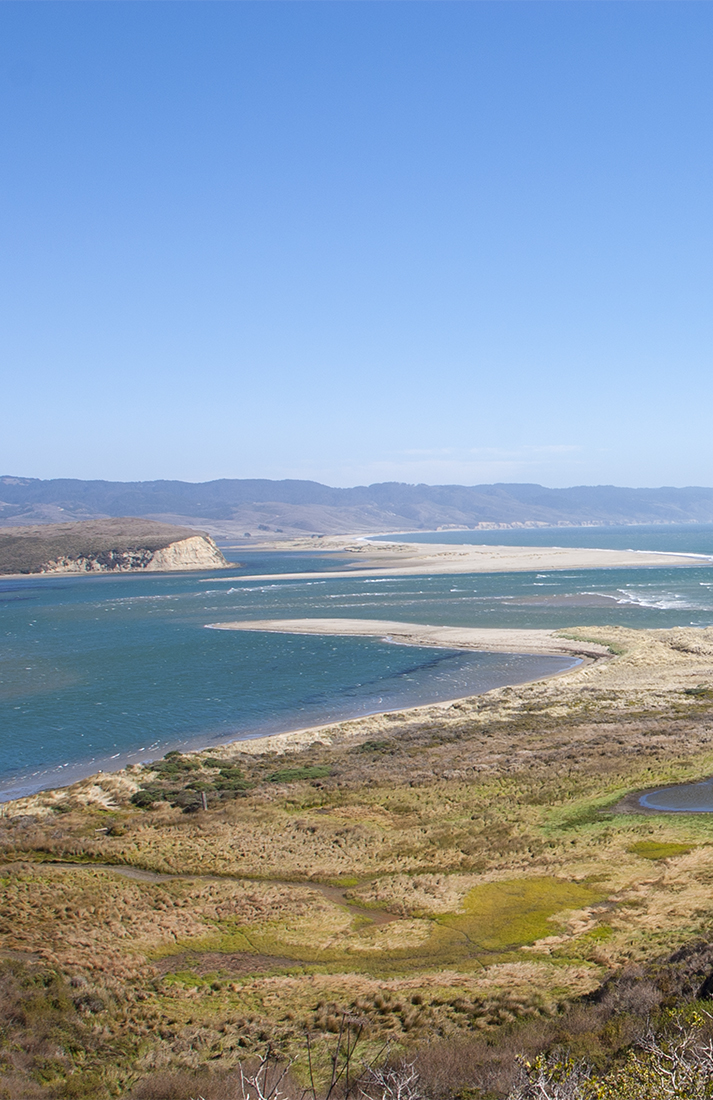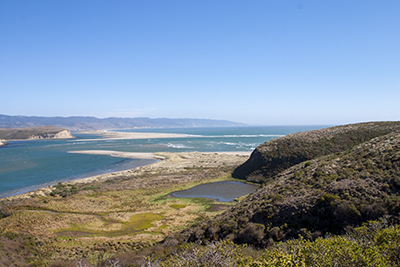 To experience summer morning at its most beautiful, Point Reyes National Seashore’s Estero Trail is hard to beat. You park at the trailhead, you follow the path through grasslands. A rabbit leaps out of your way. California quail skitter. Cattle stand silhouetted on a far hillside and above them spreads a John Constable sky: white, buxom clouds, flashes of sunlight. In 10 minutes you’re there: the estero, gray mudflats ribboned with silver water flowing toward Drakes Bay. As the place name indicates, there’s history here — it’s said that somewhere along this inlet Sir Francis Drake became the first European to bump into California. There is also an abiding sense of serenity.
To experience summer morning at its most beautiful, Point Reyes National Seashore’s Estero Trail is hard to beat. You park at the trailhead, you follow the path through grasslands. A rabbit leaps out of your way. California quail skitter. Cattle stand silhouetted on a far hillside and above them spreads a John Constable sky: white, buxom clouds, flashes of sunlight. In 10 minutes you’re there: the estero, gray mudflats ribboned with silver water flowing toward Drakes Bay. As the place name indicates, there’s history here — it’s said that somewhere along this inlet Sir Francis Drake became the first European to bump into California. There is also an abiding sense of serenity.
That serenity may be deceptive. The San Andreas Fault runs a few miles to the east; this entire peninsula is being yanked away from the North American continent. Sir Francis Drake? The location of his landing spot has sparked ferocious arguments for decades, even if the park service is commemorating him with a marker here later this year. The national seashore itself was the product of fierce debates. And those cows? They’re a controversy all to themselves.
It’s a beautiful place, Point Reyes National Seashore. But this year, as the National Park Service celebrates its 100th birthday — the official date is August 25 — it faces big questions about what the next century will hold.
JOHN DELL’OSSO IS HAPPY to enumerate all the ways Point Reyes National Seashore is special. “There’s the abundance of human and natural resources,” he says in his office at park headquarters in Bear Valley. “Eighteen percent of all the flowering plant species in California are found here. Fifty-two percent of the bird species in all of North America have been seen here. We have 60 species of mammals, both marine and terrestrial. Then you go to the human history side with the Coast Miwok people, who have been here for 3,000 to 5,000 years. Do you have that diversity in other national parks? In some. But not many.”
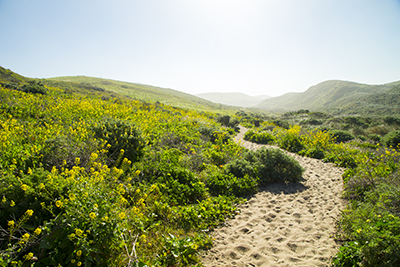 Dell’Osso may be biased. As Point Reyes’ chief of interpretation and resource education, he’s in charge of the helping the public understand the seashore. And this slice of California has been his life: he’s worked here for 30 years.
Dell’Osso may be biased. As Point Reyes’ chief of interpretation and resource education, he’s in charge of the helping the public understand the seashore. And this slice of California has been his life: he’s worked here for 30 years.
Still, Dell’Osso isn’t indulging in hyperbole. The seashore is a special place. Its 70,000 acres include 33,000 acres of wilderness and 80 miles of coastline that range from sheltered to craggy. Its high points may not wow with sheer elevation (Mount Vision rises only 1,280 feet) but the views are to die for.
So beautiful is this place that it’s easy to think, well, of course it’s been protected. In fact, the battle to bring Point Reyes into the national park system was hard-fought. To understand why, you have to travel back in time to 1960.
The years previous had been boom ones for Marin County and for the entire Bay Area. Between 1950 and 1960, Marin grew from 87,700 residents in 1950 to 148,800, and many hoped for even faster growth in the future. Much of the new development was concentrated along Highway 101. But builders looked at West Marin and said, why not develop there too? Suburban dreams blossomed. Marincello, the 150,000-person city planned for the Marin Headlands, was the most famous. But in Point Reyes projects like Drakes Bay Estates — “an exclusive recreational and residential beach development” — were nearing approval.
Citizen groups like the Point Reyes National Seashore Foundation rose up to fight the plans — by making Point Reyes a national park. It wasn’t easy. One challenge: the park service itself. Traditionally, national parks had celebrated singular natural wonders like Yellowstone’s geysers or Sequoia’s giant redwoods. However ecologically important, the more subtle beauties of an unspoiled coastline were a new priority. And local opposition was fierce. Point Reyes had a century-old heritage of cattle and dairy ranching. While many ranchers supported the seashore, others saw an unwanted federal takeover of their lands. The Marin Independent Journal ran a commentary entitled “Point Reyes Seashore? No!” and San Francisco radio station KCBS broadcast its own editorial saying that scrubby Point Reyes wasn’t pretty enough to preserve.
Working with sympathetic representatives like Congressman Clem Miller and Sen. Clair Engle, the preservationists fought back. One potent weapon was a book, Island in Time: The Point Reyes Peninsula, by science journalist Harold Gilliam with photography by Philip Hyde. In his introduction, Gilliam wrote, “By some incredible aberration, this area has escaped, thus far, the frenetic tides of human activity that elsewhere in the region have erased the evidence of history, the plant and animal life, the natural forms of the land. This is the Point Reyes Peninsula — Island in Time.”
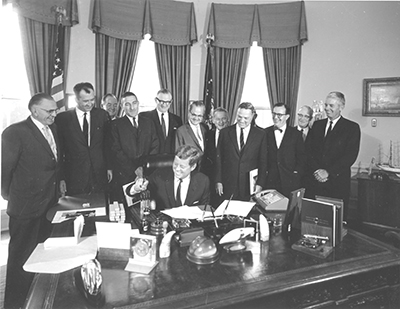
national archives
It must have helped: President John F. Kennedy signed the bill establishing Point Reyes National Seashore on September 13, 1962.
BY MIDMORNING, POINT REYES is busy. At the Bear Valley trailhead, a Union City Boy Scout troop is putting on backpacks, ready for the trek to Sky Camp, one of the seashore’s three backcountry camps. At Point Reyes Hostel, Nancy Reynolds directs guests to the Laguna Trail.
The backpackers and the hostel guests are spending the night, of course. But most of the seashore’s 2.5 million annual visitors are daytrippers, here for only two to six hours. “That’s always been a challenge for us,” Dell’Osso says. How do you get people to appreciate the park, when they’re so pressed for time? The seashore depends on educational showmanship, like the new Ocean Exploration Center that opened at Point Reyes Lighthouse in June. And on the cadre of volunteer docents who explain everything from whales to wildflowers.
Point Reyes can grab your attention all on its own, of course. It may not have geysers or giant sequoias, but it has its subdued grandeur. Walk Limantour Beach or hike Inverness Ridge, and you find yourself thinking, this is why I live in Northern California. You realize that Point Reyes offers that most valuable travel experience of all: when you’re there, you aren’t thinking about anyplace else.
POINT REYES IS BIG enough to contain surprises. There are the well-known attractions: Point Reyes Lighthouse, the tule elk that graze at the seashore’s north end. But there are also quirkier finds. The poignant Life-Saving Service Cemetery. The stable of Morgan horses. (“They’re getting on,” Dell’Osso says. “But the head of the park service rode one of them in the Rose Parade this year.”)
And, on the way to the lighthouse, one particular treasure: the old RCA wireless receiving station. From 1929 into the 1990s this station handled communications for ships all across the Pacific. Stop by on Saturday afternoon and you’ll see headphone-wearing volunteer radio operators working as if it were 1938. Chief Operator Richard Ullman will show you an impressive array of radio equipment and artifacts like the copy of the logbook in which the station transcribed the first news of the attack on Pearl Harbor — the Day of Infamy announced in Morse code.
THAT’S THE THING about Point Reyes — as much as it might not want to be, it is connected to the rest of the world. It’s an island in time, but time washes over it, and changes in the outside world eventually make themselves known here, like messages floating on radio waves across the Pacific.
One recent 21st-century challenge, Dell’Osso says, was the crowd-sourced crisis at the trailhead in Palomarin, in the south end of the park. “We started getting overwhelmed with visitors.” Social media sleuthing revealed the cause. “It turned out when people Google-mapped ‘How do I get to Point Reyes National Seashore’ from anyplace in San Francisco or south, they were told to go to Palomarin Trailhead,” Dell’Osso explains. “We had to contact Google and ask, ‘can you direct people to Bear Valley instead?’”
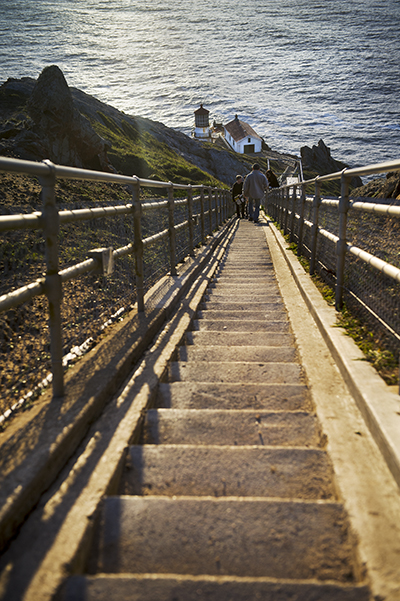
tim porter
There have been other, more serious conflicts — notably how to balance the seashore’s mandate to preserve the natural environment with its tradition of allowing agriculture use. Two years ago, the battle over Drakes Bay Oyster Company made headlines as the park service refused to extend the lease of the oyster farm on the grounds that it harmed the environmentally sensitive bay.
Now a new fight is brewing over ranching operations. Dairy and cattle ranching have a long history here, and the legislation that established the seashore allowed it to continue. Ranching draws support both from area politicians and from groups like the Marin Agriculture Land Trust. But a trio of environmental groups — the Resource Renewal Institute, the Western Watersheds Institute and the Center for Biological Diversity — have brought suit against the park service, arguing that in the 21st century ranching may no longer be the best use of the land.
The person in the hot seat over these issues is park superintendent Cecily Muldoon. She has an unusual perspective on Point Reyes. While her park service career has taken her all over the country, she grew up in Sausalito — so coming here was a homecoming. Even the controversies, she says, have their upsides. “One thing you don’t find in Marin is apathy over public lands. It’s good to have a lot of passion around the parks, even when people disagree. Whatever one’s position on any subject might be, it’s rooted in the love for this extraordinary landscape.”
IF YOU’RE LOOKING to experience evening at its most beautiful, a good place is on a kayak in Tomales Bay. The dusk light is different from the morning’s, with a soft mist blurring the bay, the calm shoreline and the forested slopes of Mount Vision — not Constable so much as Monet.
We’re on a Blue Waters Kayaking trip led by guide Liz Wilhelm. She’s proof of the passion that Point Reyes can inspire — she has the outline of the peninsula tattooed on her calf.
“Paddle now,” she says to the novice kayaker in the front of her boat. She says to be on the lookout for rays in the water and waterbirds like diving ducks.
You paddle, you peer, you think that if any place deserved to be commemorated with a tattoo it’s this one. All the congressional fights, the arguments over oysters and cows were about this: the water, the shoreline, the distant mountain. You think, you may want to return tomorrow. And that when you do Point Reyes seashore will still be there.
5 Point Reyes Essentials
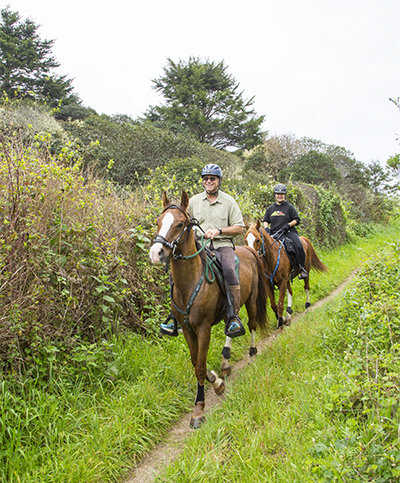 THE POINT REYES LIGHTHOUSE The 1870-vintage light station has insane Pacific views and now the small but engaging Ocean Discovery Center to go with its existing exhibits. West end of Sir Francis Drake Boulevard, 20 miles west of Bear Valley Visitor Center. Open Friday– Monday, but check nps.gov/ pore for current hours.
THE POINT REYES LIGHTHOUSE The 1870-vintage light station has insane Pacific views and now the small but engaging Ocean Discovery Center to go with its existing exhibits. West end of Sir Francis Drake Boulevard, 20 miles west of Bear Valley Visitor Center. Open Friday– Monday, but check nps.gov/ pore for current hours.
RCA COAST STATION On Sir Francis Drake Boulevard 10 miles west of Bear Valley Visitor Center — watch for North District Operation Center sign. Open noon–4 p.m., Saturdays.
POINT REYES YOUTH HOSTEL Park access is unparalleled, the price is right — from $29 for a dorm bed to $105 for a private room — and the ambience is IKEAinviting, not aged hippie. norcalhostels.org/reyes
ESTERO TRAIL The seashore is laced with good trails, but this one is especially appealing — it’s short (two miles round-trip if you go only to the bridge over the estero) and easy, and the views are lovely. Off Sir Francis Drake Boulevard about two miles past Pierce Point Road; follow signs to trailhead.
KAYAKING Blue Waters Kayaking leads tours of Tomales Bay and Drakes Estero; bluewaterskayaking. com. Other outfitters running tours include Point Reyes Outdoors, pointreyesoutdoors.com.
What's Next?
The National Park System looks at the the next hundred years.
The National Park System celebrates its 100th birthday this month. But the NPS — and all the people and groups who love and use national parks — are also asking questions about what the parks’ priorities for the next century should be. These are the most important trends.
Make Parks More Relevant Traditionally, the prime audience for national parks has been white, middle class and middle aged. That no longer reflects California or the U.S., says Scott Gediman, chief public information officer at Yosemite. “It’s our responsibility to reach out to the next generation — to show them the value of parks. Otherwise, there’s no guarantee parks will still be protected.”
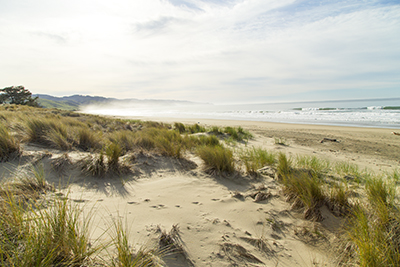 One organization working hard to reach out is San Francisco–based NatureBridge, which offers educational programs in many California national parks. In Yosemite, its WildLink program takes kids from underserved populations and leads them on weeklong treks into the Sierra backcountry. “These are kids who haven’t been to a national park before, haven’t hiked before,” says Yosemite NatureBridge Director Kristina Rylands. “We provide all the gear and the food and they go out with our educators for a week. We want to connect them with the values of wilderness.”
One organization working hard to reach out is San Francisco–based NatureBridge, which offers educational programs in many California national parks. In Yosemite, its WildLink program takes kids from underserved populations and leads them on weeklong treks into the Sierra backcountry. “These are kids who haven’t been to a national park before, haven’t hiked before,” says Yosemite NatureBridge Director Kristina Rylands. “We provide all the gear and the food and they go out with our educators for a week. We want to connect them with the values of wilderness.”
Citizen Science Parks are vital centers for environmental research and now, more than ever, ordinary citizens are helping out. “Citizen science has become a very powerful way for people without advanced training to help save nature,” says San Francisco environmental writer Mary Ellen Hannibal, whose book Citizen Scientist: Searching for Heroes and Hope in an Age of Extinction comes out this month. The California Academy of Sciences sponsors programs in many Northern California parks, using its iNaturalist mobile app.
Restore, Restore, Restore Some of the best park news comes when the park service fixes damage done in the past. At Point Reyes National Seashore, restoration of the Giacomini Wetlands has increased the population of shorebirds like the least sandpiper; directors hope the seashore’s current dune restoration project will have equally beneficial effects. In Yosemite, restoration of the iconic Mariposa Grove of sequoias is scheduled for completion next year.
